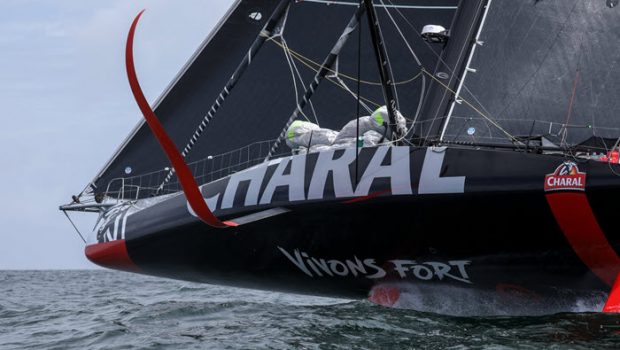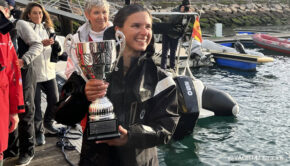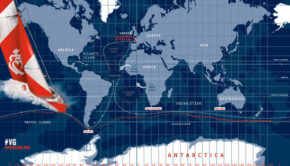Preparing for an epic Vendée Globe
Published on July 15th, 2020
The Vendée Globe is the only sailing race round the world that’s solo, non-stop, and without assistance, and it is all systems go for the 9th edition on November 8, 2020. Beginning in 1989 with 13 entries, the start line on November 8th may see up to 35 skippers set off from Les Sables d’Olonne, France.
As the competition calendar crumbles in 2020, this race will see the IMOCA Class boats hurl themselves around the world, teetering on carbon foils through inhospitable regions, chasing the record set in 2016-17 by Armel le Cléac’h of 74:03:35:46.
With the heightening performance of these 60-foot composite missiles, it will be the most extreme edition ever, and adding to the drama are the new builds, many untested due to the coronavirus pandemic.
The 3600nm Vendée-Arctique les Sables d’Olonne Race, won this week by Jérémie Beyou at the helm of Charal, was designed as a substitute for two cancelled transatlantic races. The hope was that it would give the Vendée Globe sailors some confidence and time on the water in a competitive setting, as they continue their preparations for the round-the-world course in a season that has been beset by the COVID-19 lockdown.
The south-north journey, which took the fleet from Les Sables d’Olonne to the Azores after a turning mark off Iceland and then back to Les Sables, crossed waters previously unknown to the majority of the class and it involved crossing several weather systems, with phases of strong upwind and downwind sailing but also plenty of light airs and flat water.
What few observers guessed was that this would produce an intense battle that felt more like a grand prix than a marathon. But the testimony of the sailors at the finish also tells us that it fulfilled their hopes as a testbed for the Vendée Globe in many respects.
The skippers were able to experience life on board in a competitive environment, get used to living in the hostile conditions of a super-fast foiling 60-footer on the ocean and practice speed techniques in close proximity to their rivals.
“I didn’t feel like setting off on the Vendée Globe without at least having done a test race single-handed,” said second-placed Charlie Dalin on Apivia. “To do that the Vendée-Arctique fulfilled its role perfectly as we had lots of situations to deal with, transitions and sail changes. It was a perfect training race to prepare for the Vendée Globe and thus validate all the work undertaken on the boats.”
Dalin used the race to test his competitiveness against winner Beyou and third-placed Thomas Ruyant on LinkedOut. “It was a very rewarding race and what’s nice is that the three of us didn’t let go of each other…above all, I learnt everything about sail choices and how to change them, how to do the maneuvers in different ways, at different levels of intensity.”
Beyou, meanwhile, who crossed the finish line off Les Sables d’Olonne 50 minutes ahead of Dalin and 70 minutes ahead of Ruyant, saw the Vendée-Arctique as a unique format. “The course had never been sailed before,” he said. “Inevitably there were a fair few unknowns with the added pressure of not knowing if you and your boat were ready for the Vendée Globe, because it’s coming up fast.”
The remarkably successful sailor admitted that he had treated this as a serious competitive challenge from the word go. “I’d put pressure on myself, all on my own,” he said. “It was important for me to sail well…I was tense for the whole of the start of the race and then gradually relaxed into it, but it wasn’t easy to live with the whole time.”
Samantha Davies, who finished fourth on Initiatives-Coeur, was the leading skipper in the older generation boats that have been modified to accept foils.
“It was a real pleasure to get back out on the water in the solo format,” she said after getting in 55 minutes ahead of her nearest rival, Kévin Escoffier on PRB. “It had been such a long time. Me and my boat, we’re ready for the Vendée Globe. We’ve validated the latest modifications made over the winter…I made the most of the opportunity to test lots of things, from trimming to freeze-dried food – everything was geared around the Vendée Globe.”
Escoffier said he was very happy that IMOCA had managed to get this race established and approved. “The class has really worked well to be able to organize this,” he said. “Without this race, qualifying for the Vendée Globe would have been very complicated, for safety reasons too. IMOCA has managed it brilliantly,” he added.
The intensity of this race was quite remarkable with countless lead changes and five skippers at the head of the leaderboard at various times over 10 days at sea, with the first 12 boats finishing within seven hours and 10 minutes of each other after the course was shortened to 2,800 nautical miles.
Among the most impressive performers were Beyou, Dalin and Ruyant at the head of affairs, Sam Davies leading the older boats and Maxime Sorel and Clarisse Crémer in the leading non-foiling monohulls.
Crémer led Sorel for much of the race before surrendering the initiative in the closing stages. In the end Sorel pipped her by one place, finishing in 11th position on V&B Mayenne, 51 minutes ahead of the Banque Populaire X skipper.
Finally, a last word from Beyou who is not under-estimating the importance of his victory in this warm-up for the Vendée Globe. “Managing to do things right and secure the win, I can kind of settle down a bit,” he said. “I no longer feel this pressure on the eve of the Vendée Globe start. I know where I’m going, how you have to get there and that is a great victory in itself.
“One image that I retain from this race is the final tack to the finish,” he added. “It was champagne sailing. There was 17 to 20 knots, 120 to 130 degrees to the wind, the boat was up on her foil in flat seas and Charal was really great. It was fantastic.”
Source: Ed Gorman









 We’ll keep your information safe.
We’ll keep your information safe.